Table of Contents
- Introduction
- Editor’s Choice
- Digital Content Creation Market Overview
- Different Types of Digital Content Creation
- Number of Digital Content Creators Worldwide – By Country
- Time Spent Creating Digital Content by Social Media Creators Worldwide
- Earnings of Digital Content Creators
- Digital Content Management Technology
- Challenges in Digital Content Creation
Introduction
According to Digital Content Creation Statistics, Digital content creation encompasses the production of diverse media content for online consumption, spanning written articles, videos, podcasts, graphics, and interactive experiences.
With the proliferation of digital platforms and increased internet penetration, demand for engaging content is surging.
Video content remains dominant, with platforms like YouTube and TikTok driving engagement, while emerging formats like live streams and AR offer new engagement opportunities.
Content creators, platforms, agencies, and technology providers constitute the market landscape, navigating challenges such as content saturation and algorithmic changes while capitalizing on opportunities in monetization models and emerging technologies like Generative AI and VR.
Understanding these dynamics is crucial for businesses and creators aiming to thrive in the competitive digital content space.
Editor’s Choice
- In 2023, the global digital content creation market revenue stood at USD 27.1 billion.
- By the end of 2033, the total market is projected to climb to USD 90.4 billion, with tools generating USD 67.62 billion and services reaching USD 22.78 billion, indicating a robust expansion and sustained demand across both segments.
- Various types of content categorize the market, each holding a significant share. Video content dominates the market with a 40% share, reflecting its widespread use and high consumer engagement.
- In the 2022 HubSpot State of Content Marketing Report, it was found that 56% of marketers believe blogs are the most effective type of content.
- A recent HubSpot survey revealed that a significant 82% of content creators and marketers repurpose their content for social media platforms.
- Brazil leads in the distribution of digital content creators with a substantial number, hosting approximately 106 million digital content creators, the highest among surveyed nations.
- In 2017, the earnings of U.S. creators on leading platforms exhibited varied growth and decline relative to the previous year. YouTube led with significant earnings of approximately $4,004 million, marking a 21.10% increase from 2016.
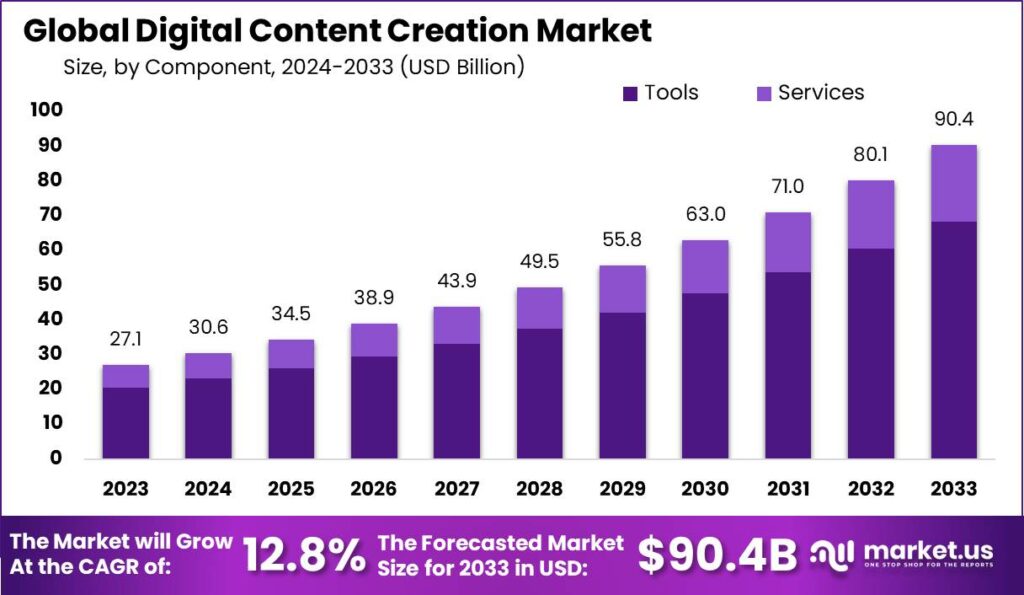
Digital Content Creation Market Overview
Global Digital Content Creation Market Size
- The global digital content creation market is projected to grow significantly over the next decade at a CAGR of 12.8%.
- In 2023, the market revenue stood at USD 27.1 billion. It is forecasted to rise to USD 30.6 billion in 2024 and continue its upward trajectory to reach USD 34.5 billion by 2025.
- By the end of 2033, the market is expected to surge to approximately USD 90.4 billion, illustrating a robust expansion over the ten years.
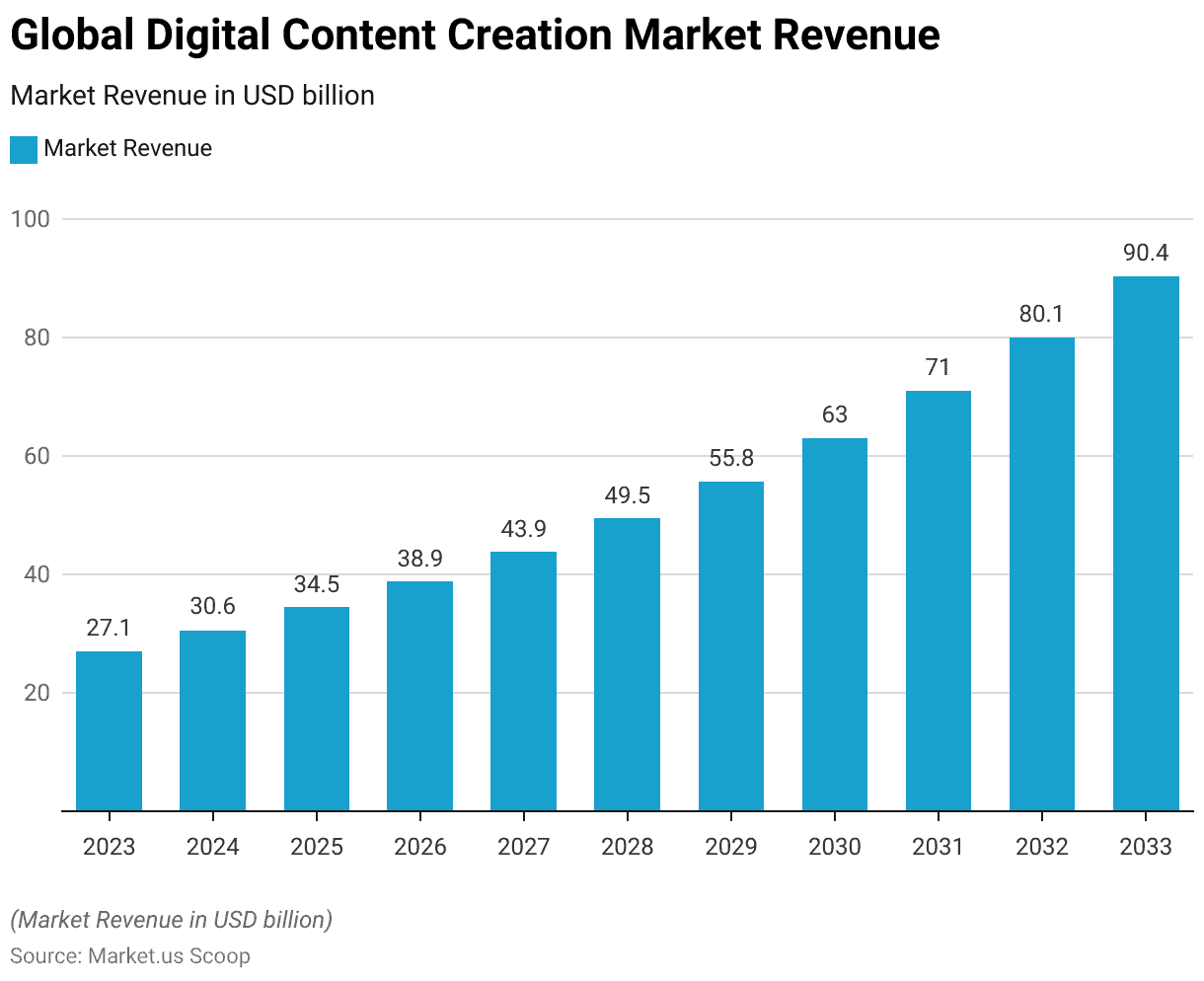
Digital Content Creation Market Size – By Component
- The Global Digital Content Creation market is segmented into tools and services, showing distinct growth patterns in each category over a forecasted period from 2023 to 2033.
- In 2023, the market started with a total revenue of USD 27.1 billion, split between USD 20.27 billion from tools and USD 6.83 billion from services.
- By the end of the forecast period in 2033, the total market is projected to climb to USD 90.4 billion, with tools generating USD 67.62 billion and services reaching USD 22.78 billion, indicating a robust expansion and sustained demand across both segments.
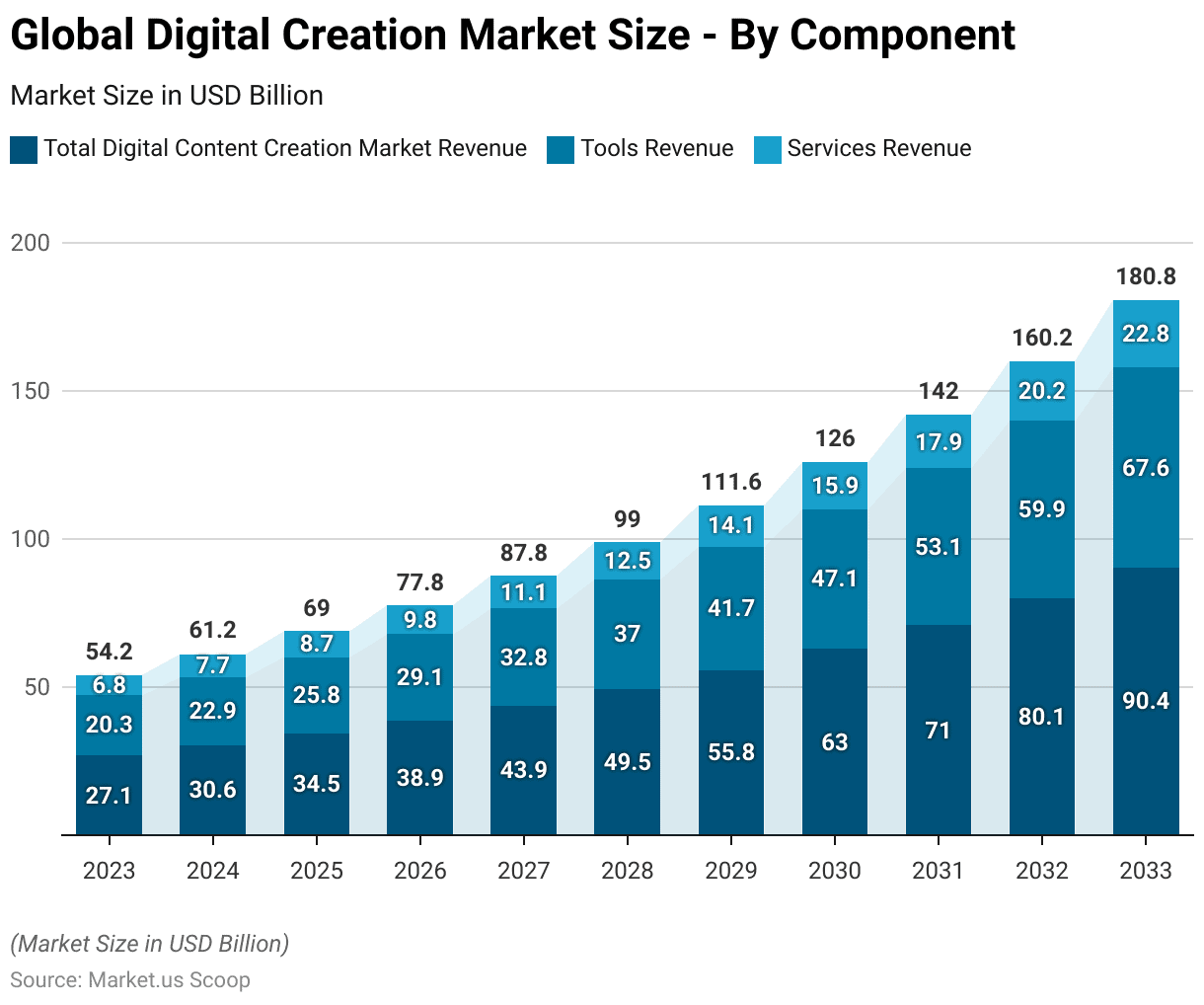
Digital Content Creation Market Share – By Content Type
- Video content dominates the market with a 40% share, reflecting its widespread use and high consumer engagement.
- Graphical content follows with a 28% market share, showcasing its essential role in digital advertising and media.
- Textual content holds a 15% share, underlining its importance in content marketing and online communication.
- Audio content contributes 17% to the market, highlighting the growing popularity of podcasts and other audio-based media.
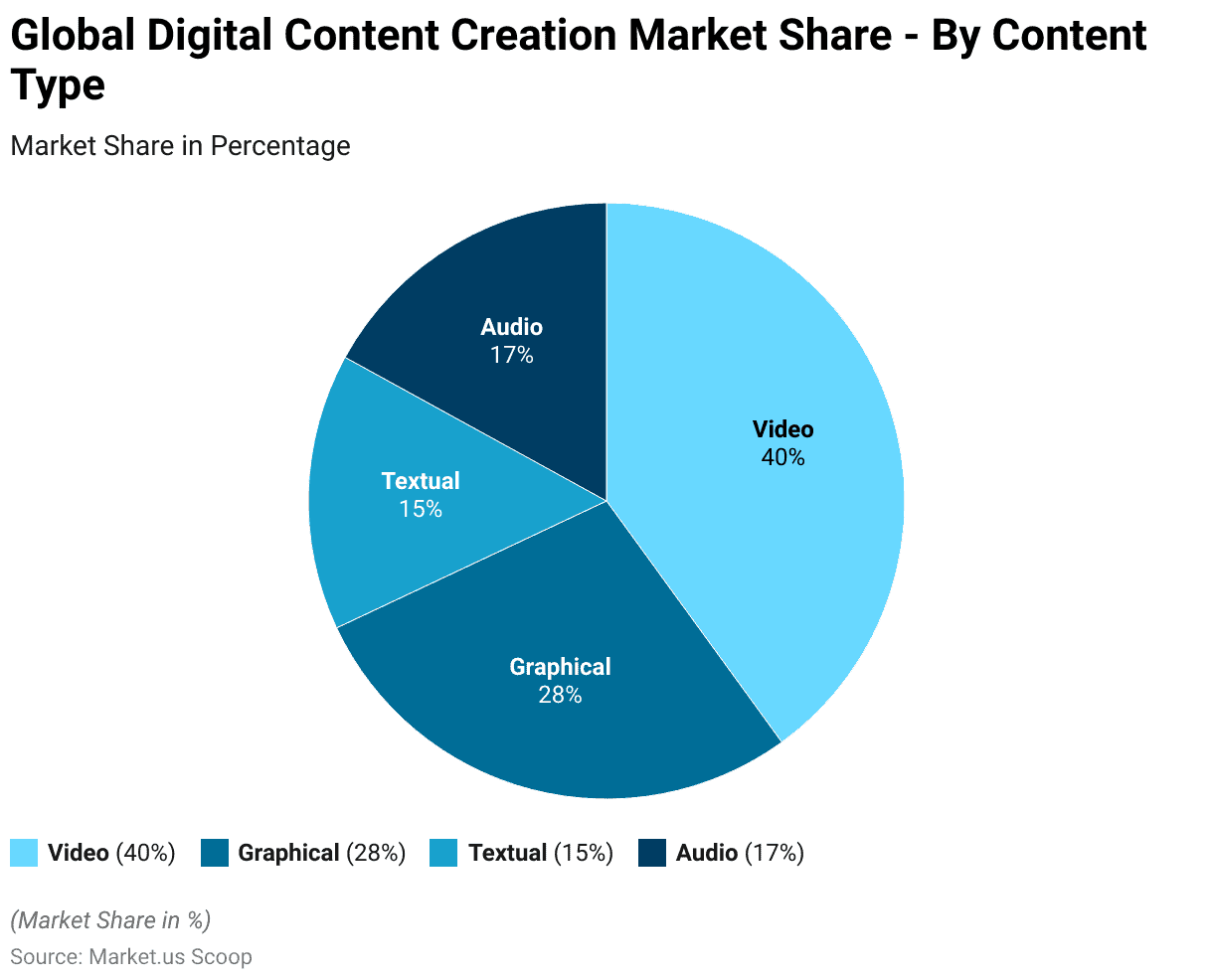
Different Types of Digital Content Creation
Video Content Creation Statistics
Most Popular Video Content – By Weekly Usage Reach
- An overwhelming 92% of respondents engaged with any video content, reflecting the ubiquitous nature of video in daily media consumption.
- Music videos were the second most popular, with 49.70% of respondents viewing them, illustrating their enduring appeal.
- Comedy, meme, or viral videos also held significant traction, engaging 35.30% of the audience, likely due to their entertaining and shareable nature.
- Video live streams were watched by 27.70% of respondents, suggesting a robust interest in real-time interaction and content.
- Tutorials or how-to videos, as well as educational videos, both maintained a steady interest, capturing 25.70% and 25.60% of respondents, respectively, indicative of a strong desire for learning and skill development through video.
- Product review videos were viewed by 25% of the audience, emphasizing their role in consumer decision-making.
- Sports clips or highlights and influencer videos and vlogs also had considerable viewership at 24.90% and 23.80%, respectively.
- Lastly, gaming videos were watched by 23.20% of respondents, highlighting the significant niche of gaming content in the digital video space.
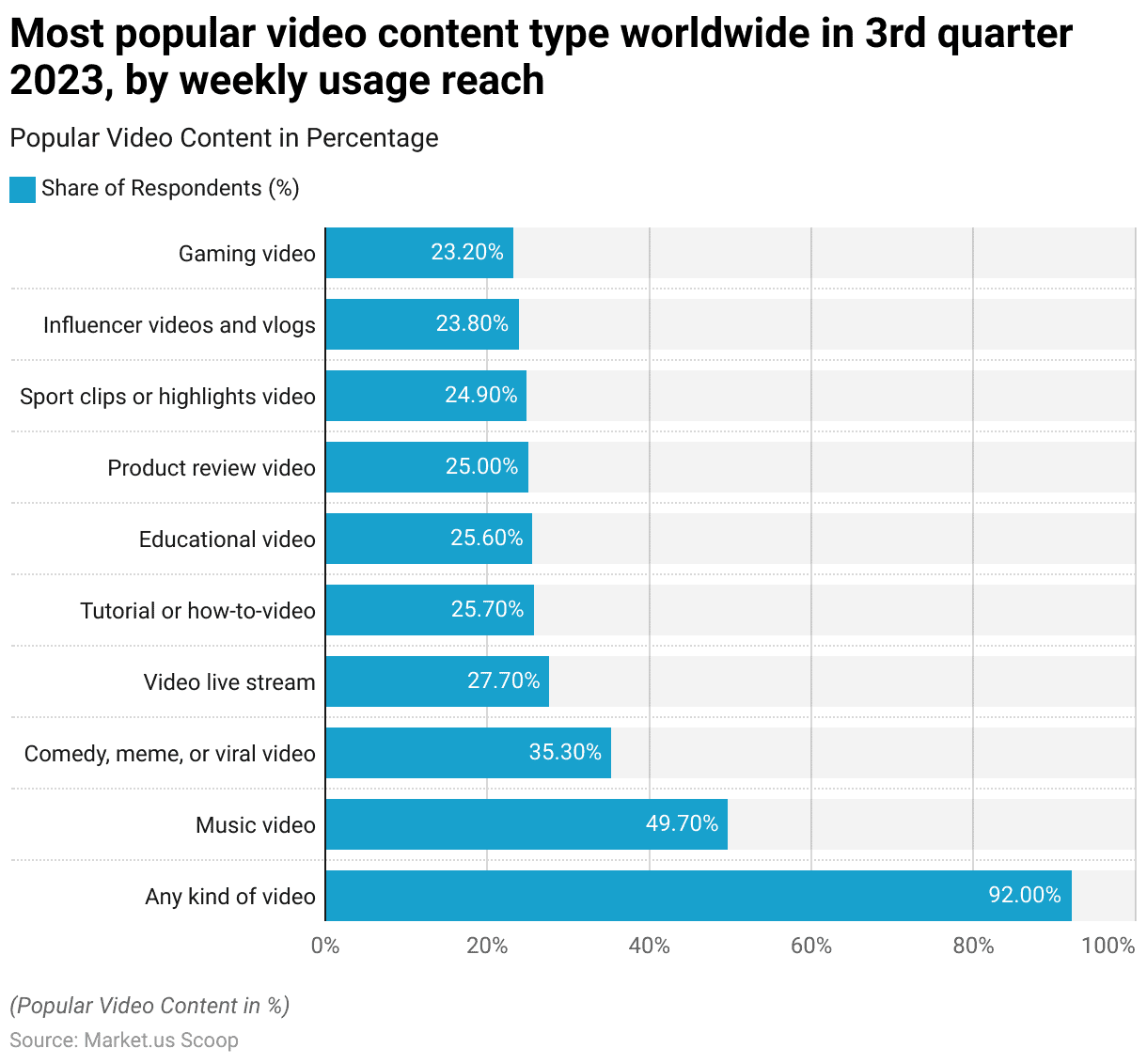
Blog Content Creation Statistics
- In the 2022 HubSpot State of Content Marketing Report, it was found that 56% of marketers believe blogs are the most effective type of content.
- Another OrbitMedia report also emphasized blogs’ value, with 1 in 5 content creators experiencing significant success with them.
- Surprisingly, despite the crucial role of research in content creation, only 41% of bloggers include original research in their posts, according to OrbitMedia’s survey.
- In terms of blog post length, the average post in 2021 was around 1416 words, and longer-form content (over 2,000 words) is becoming increasingly popular compared to shorter pieces.
B2B & B2C Content Creation Statistics
- The HubSpot State of Inbound Marketing Trends 2022 Report indicates that B2B companies primarily focus on developing case studies, blogs, whitepapers, and interviews. In contrast, B2C businesses find shorter content formats more lucrative.
- Effective SEO strategies are essential for B2B firms to boost organic traffic and drive sales, with 77% of B2C and 66% of B2B content marketers incorporating SEO into their content creation methods.
- Looking forward, the CMI B2B Content Marketing Insights for 2022 report suggests a significant shift towards video as a key channel for B2B content creation and marketing.
Social Media Content Creation Statistics
- A recent HubSpot survey revealed that a significant 82% of content creators and marketers repurpose their content for social media platforms.
- The HubSpot State of Inbound Marketing Trends 2022 report emphasizes that the most impactful content types for social media engagement include humor, with 80% of marketers favoring it, followed by interactive content (preferred by 77% of marketers) and content that aligns with the brand’s values (preferred by 63% of marketers).
Number of Digital Content Creators Worldwide – By Country
- As of May 2022, the distribution of digital content creators globally varies significantly by country.
- Brazil leads with a substantial number, hosting approximately 106 million digital content creators, the highest among surveyed nations.
- The United States follows with 86 million creators, making it another major hub for digital content production.
- Germany and Japan also contribute notable figures, with 19 million and 18.5 million content creators, respectively.
- South Korea and Spain are closely matched, having 17.5 million and 17 million content creators.
- In the United Kingdom, there are about 16.6 million digital content creators, while France has slightly fewer at 16.5 million.
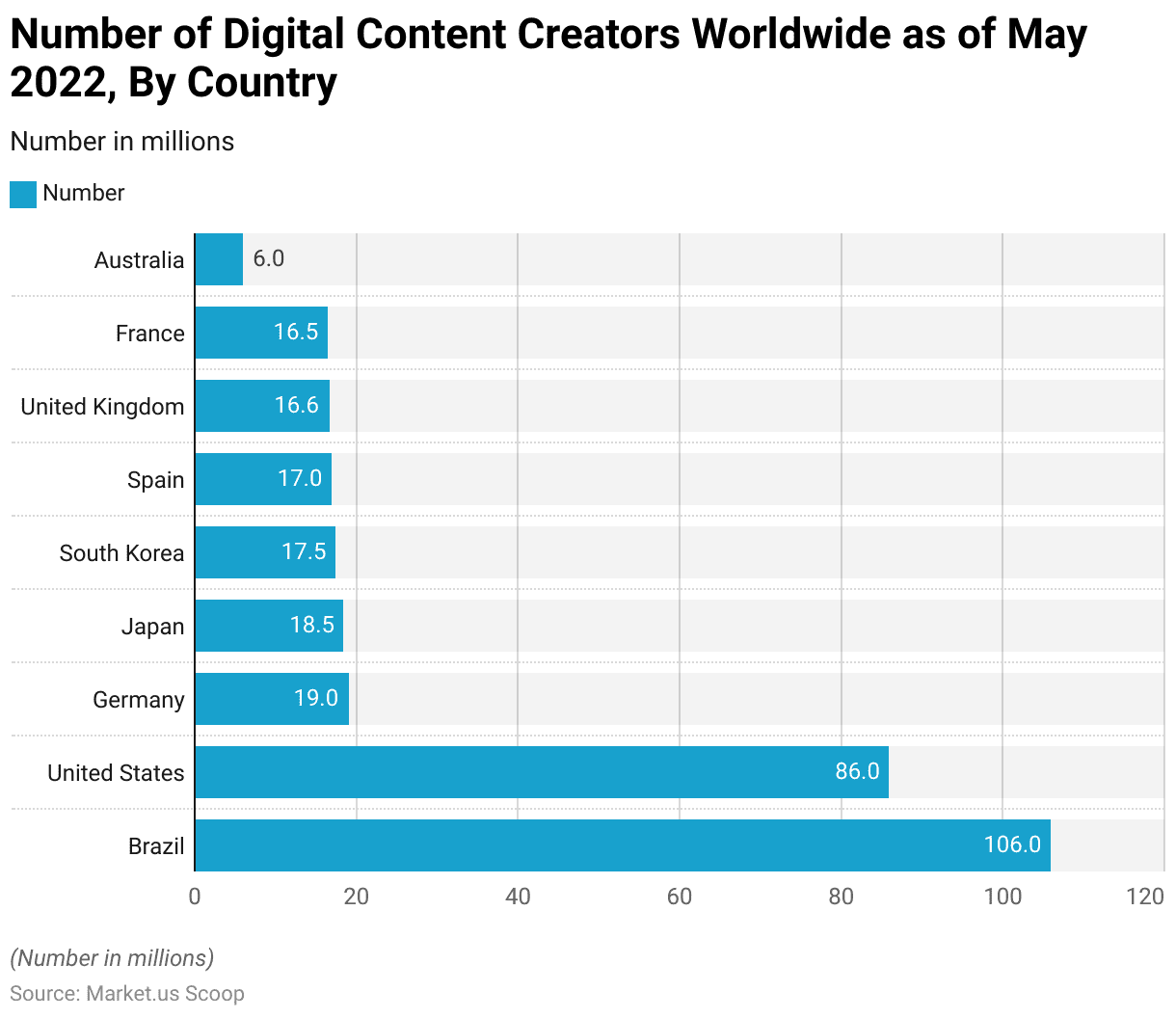
Time Spent Creating Digital Content by Social Media Creators Worldwide
- In 2021, the time invested in creating digital content by social media creators worldwide showed a diverse range of commitment.
- A small segment of respondents, 7%, reported spending between 0 to 1 hour per week on content creation, indicating a casual engagement.
- The largest group, comprising 36% of respondents, spent between 1 to 5 hours weekly, reflecting a more regular but moderate involvement.
- Another 27% dedicated 5 to 10 hours each week, suggesting a significant investment in content creation.
- A substantial 16% of creators spent 10 to 20 hours weekly, demonstrating a deeper commitment.
- Furthermore, 9% of respondents reported spending 20 to 40 hours per week, indicating near-professional or full-time engagement in content creation.
- Notably, a smaller group, 5%, invested more than 40 hours weekly, showcasing an extensive commitment typically seen among professional content creators.
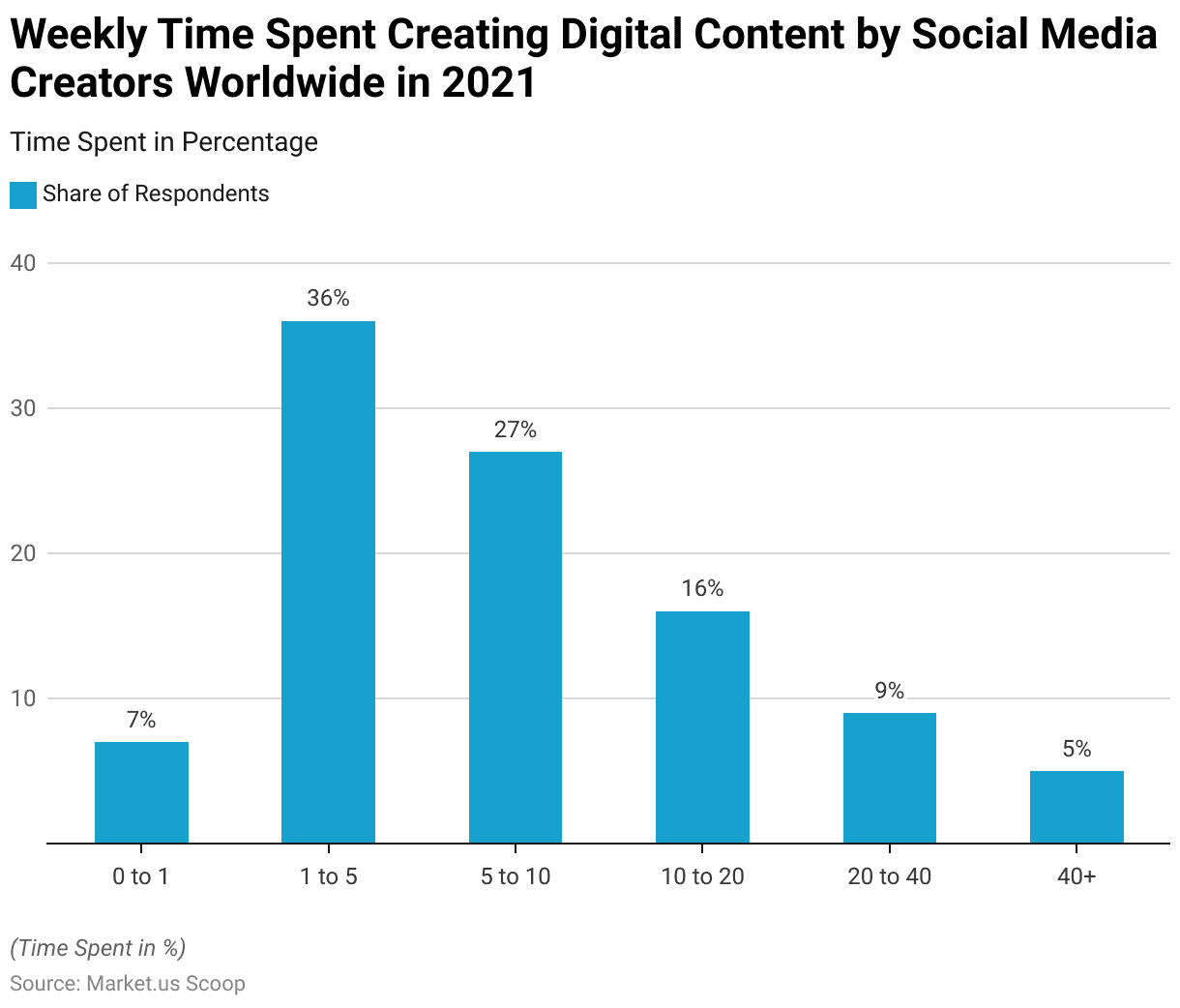
Earnings of Digital Content Creators
Revenue Generated by Content Creators and Influencers via Social Media Platforms
- As of September 2023, the revenue generated by content creators and influencers via social media platforms over the last 12 months displays a wide distribution.
- A significant majority of 72% of creators earned less than $500, indicating that most are likely engaging in content creation on a small scale or perhaps as a hobby.
- Meanwhile, 17% of creators earned between $500 and $5,000, suggesting some level of monetization beyond casual activity.
- A smaller segment of 5% generated revenues between $5,000 and $10,000, reflecting a more substantial engagement in content creation as a potential part-time income source.
- Further up the scale, 4% of influencers earned between $10,000 and $50,000, likely representing those who pursue content creation with a more professional approach.
- Only 2% of creators earned over $50,000, indicating a select group who have successfully leveraged their platforms to achieve significant financial returns.
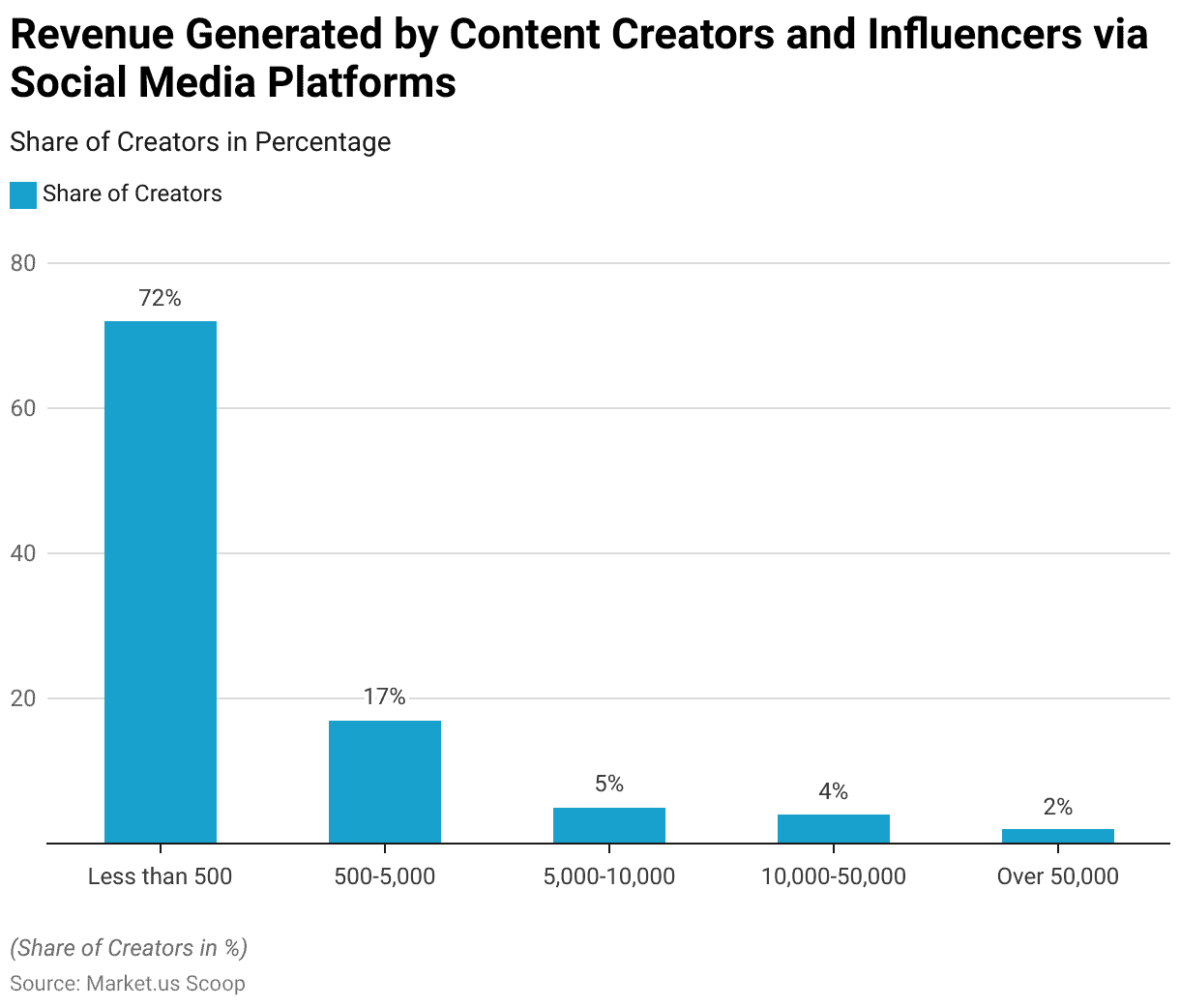
Platforms Where Online Creators Make Money
- YouTube led with significant earnings of approximately $4,004 million, marking a 21.10% increase from 2016.
- Etsy also saw a positive change, generating $1,459 million with a 13.40% rise.
- Instagram showed the most substantial growth among the platforms, with earnings reaching $460 million, a 49.50% surge, indicating a rapidly increasing monetization potential on the platform.
- On the other hand, WordPress experienced a decline, with earnings dropping by 20.80% to $348 million.
- Amazon Publishing had a modest increase of 1.60%, resulting in earnings of $220 million.
- Tumblr’s earnings grew by 22.60% to $178 million, reflecting a solid increase.
- Lastly, Twitch, the streaming platform, had earnings of $87 million, marking a significant 30% growth from the previous year.
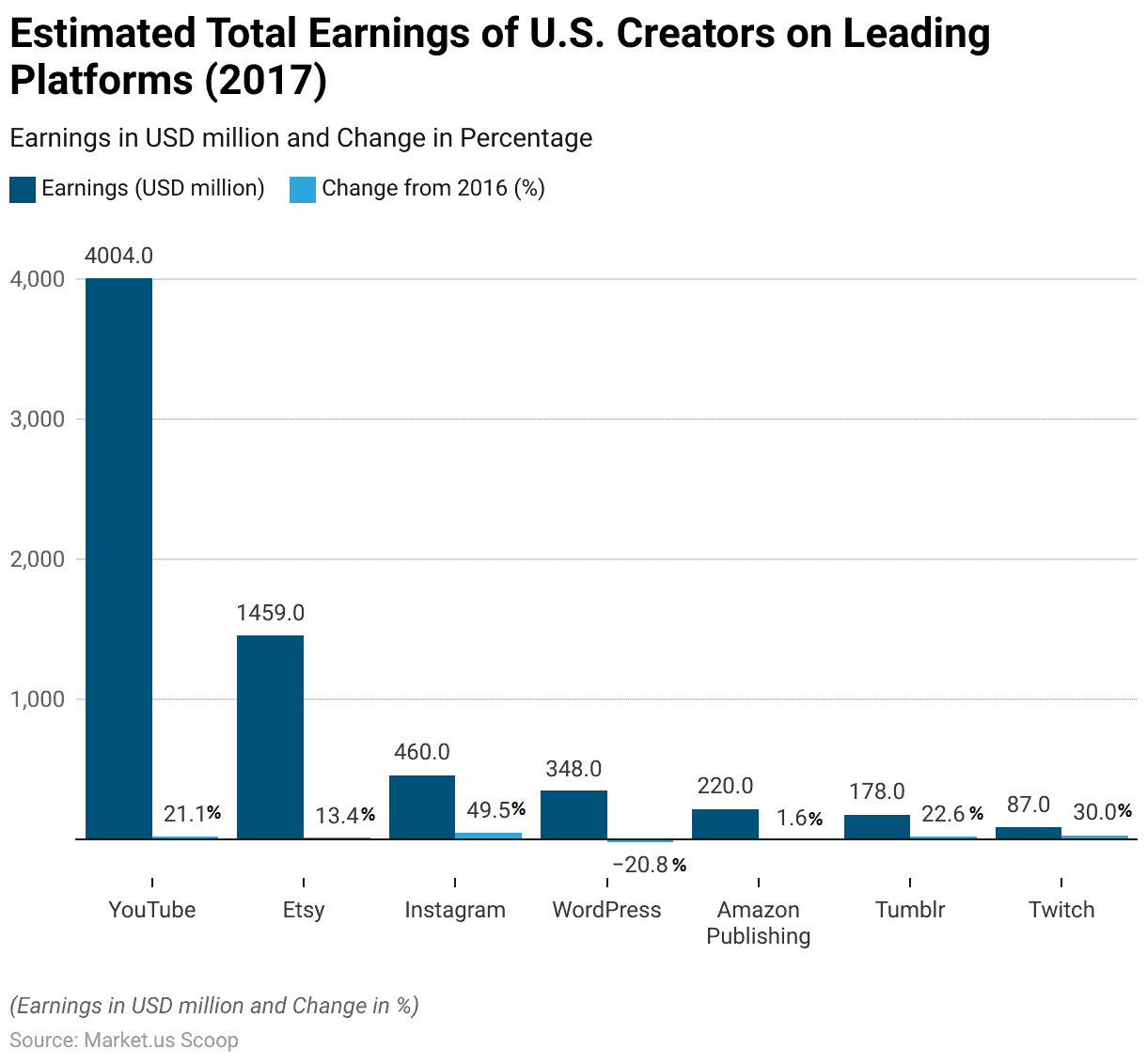
Digital Content Management Technology
- Just 31% of B2B marketers claim their organization possesses the appropriate content management technology.
- Another 30% acknowledge having the technology but not fully utilizing its capabilities, and 29% admit to not having acquired the suitable technology.
- A further 10% remain uncertain about their technological adequacy.
- Looking ahead, 45% of B2B marketers express the likelihood of their organization investing in further content management technology in 2024.
- Conversely, 32% express reluctance towards additional tech investments, while 23% remain neutral regarding the likelihood of such investments.
Challenges in Digital Content Creation
- In the realm of producing engaging visual content, creators faced several notable challenges.
- The largest struggle, identified by 36.70% of respondents, was producing content consistently, highlighting the difficulty in maintaining a steady flow of fresh and engaging material.
- Finding the right layout for data, statistics, or copy was also a significant challenge, with 22.90% of respondents expressing difficulty effectively organizing visual elements to convey their message.
- Great design posed a hurdle for 20.50% of creators, indicating that achieving an aesthetically pleasing and impactful presentation is a common concern.
- Additionally, sourcing data and statistics necessary for writing the copy was a struggle for 19.90% of respondents, underscoring the importance of robust and relevant data to inform and enrich visual content.
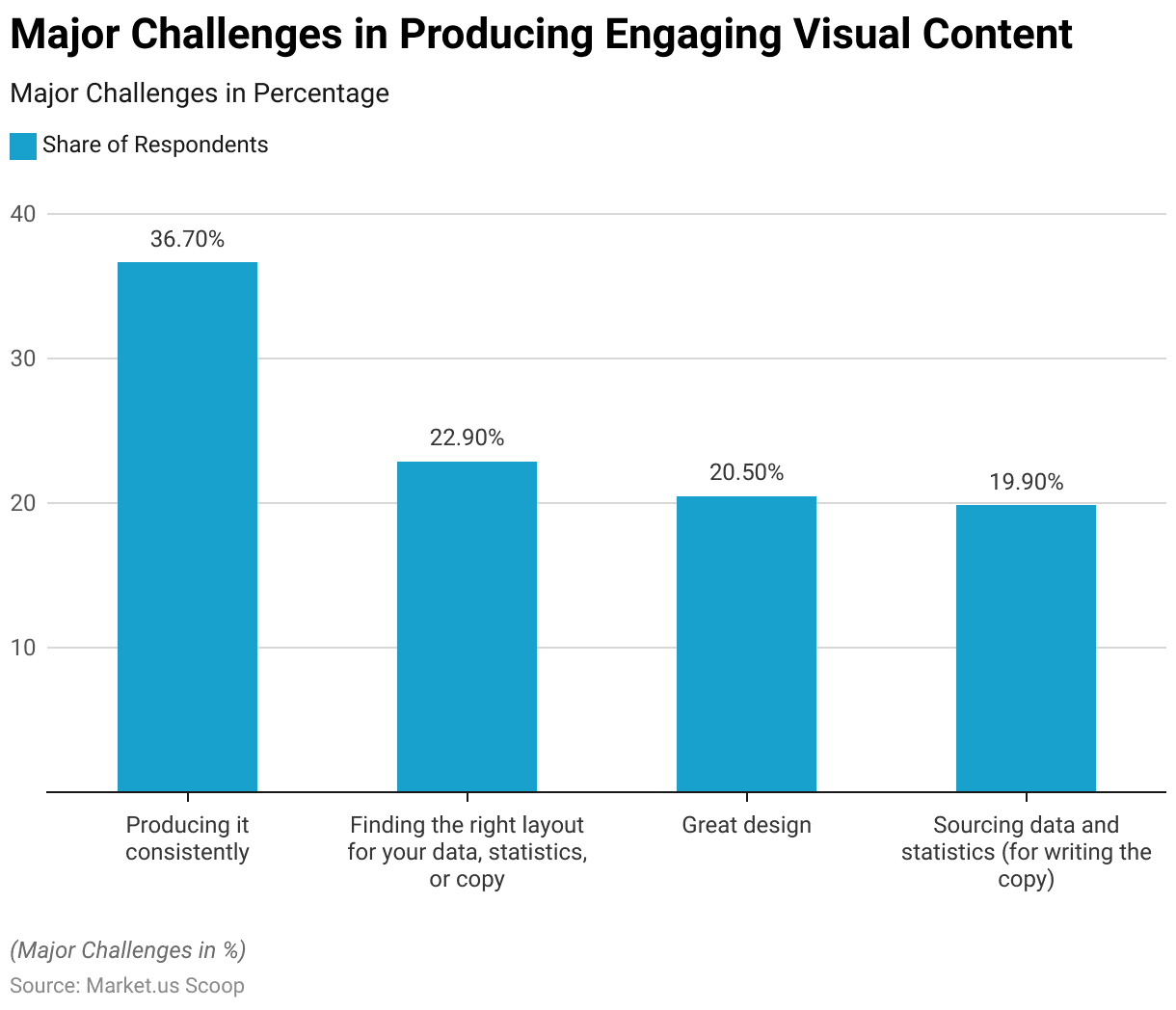
Discuss your needs with our analyst
Please share your requirements with more details so our analyst can check if they can solve your problem(s)



